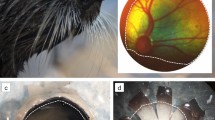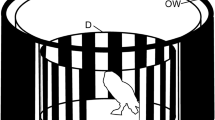Summary
In an examination of the focusing abilities of 15 species of owls, the North American barn owl, Tyto alba pratincola (Bonaparte 1838), was an outstanding accommodator, having a range of accommodation exceeding 10 diopters (Murphy and Howland 1983). Using comparable methods, we examined the accommodation of 4 specimens of the Australian barn owl, Tyto alba delicatula (Gould 1837). We failed to elicit accommodation greater than two diopters, and most stimuli failed to evoke any discernable accommodation at all. Furthermore, examination of other Australian tytonid owls, the grass owl, T. longimembris, the sooty owl, T. tenebricosa, and both the mainland and Tasmanian subspecies of the masked owl, T. novaehollandiae novaehollandiae and T. novaehollandiae castanops, also failed to reveal anything but very moderate accommodative ranges. We conclude that the outstanding accommodative ability of the American barn owl is truly an exception to the modest accommodative abilities of the tytonid owls generally.
Similar content being viewed by others
References
Bunn DS (1977) The voice of the barn owl. British Birds 70:171
Bunn DS, Warburton AB, Wilson RDS (1982) The barn owl. Poyser: Calton
Burton JA (1973) Owls of the world. EP Button, New York
Campbell FW, Westheimer G (1960) Dynamics of accommodation responses of the human eye. J Physiol (Lond) 151:285–295
Fleishman LJ, Howland HC, Howland MJ, Rand AS, Davenport ML (1988) Crocodiles don't focus underwater. J Comp Physiol A 163:441–443
Glickstein M, Millodot M (1970) Retinoscopy and eye size. Science 168:605–606
Herrera CM (1974) Trophic diversity of the barn owl, Tyto alba, in continental western Europe. Ornis Scand 5:181–191
Howland HC (1985) Optics of photoretinoscopy: Results from ray tracing. Am J Optom Physiol Opt 62:621–625
Howland HC, Howland B (1974) Photorefraction: A technique for study of refractive state at a distance. J Opt Soc Am 64:240–249
Howland HC, Sayles N (1984) Photorefractive measurements of astigmatism in infants and young children. Invest Ophthalm Visual Sci 25:93–102
Howland HC, Braddick O, Atkinson J, Howland B (1983) Optics of photorefraction: orthogonal and isotropic methods. J Opt Soc Am 73:1701–1708
Konishi M (1973) How the owl tracks its prey. Am Sci 61:414–424
Marshall JT (1978) Systematics of smaller Asian night birds based on voice. Ornithological Monographs 25:1-58 American Ornithologist's Union:U. Southern Florida, Tampa
Murphy CJ, Howland HC (1983) Owl eyes: Accommodation, corneal curvature and refractive state. J Comp Physiol A 151:277–284
Murphy CJ, Howland HC, Kwiecincinski GG, Kern T, Kallen F (1983) Visual accommodation in the flying fox (Pteropus giganteus). Vision Res 23:617–620
Pettigrew JD, Little L, Steginga T (1986) Incubation period of the Australian grass owl Tyto capensis longimembris. Emu 86:117–118
Schaeffel F, Farkas L, Howland HC (1987) Infrared retinoscope. Applied Optics 26:1505–1509
Schaeffel F, Howland HC (1988) Visual optics in normal and ametropic chicks. Clin Vision Sci 3:83–98
Schodde R, Mason IJ (1981) Nocturnal birds of Australia. Lansdowne, Melbourne
Sivak J, Howland HC, McGill-Harelstad P (1987) Vision of the Humboldt penguin (Spheniscus humboldti) in air and water. Proc R Soc Lond B 229:467–472
Volman S, Konishi M (1989) Spatial selectivity and binaural responses in the inferior colliculus of the great horned owl. J Neurosci 9:3083–3096
Walls GL (1942) The vertebrate eye and its adaptive radiation. 1967 facsimile of 1942 edition. Hafner, New York
Author information
Authors and Affiliations
Rights and permissions
About this article
Cite this article
Howland, H.C., Rowland, M.J., Schmid, K. et al. Restricted range of ocular accommodation in barn owls (Aves:Tytonidae). J Comp Physiol A 168, 299–303 (1991). https://doi.org/10.1007/BF00198349
Accepted:
Issue Date:
DOI: https://doi.org/10.1007/BF00198349




